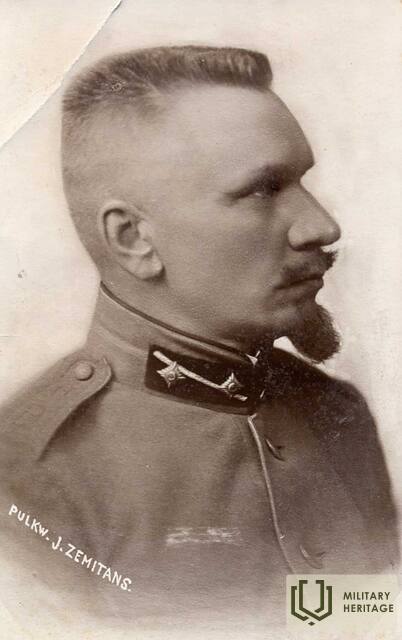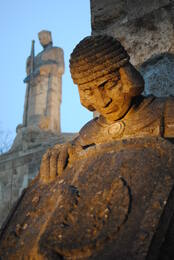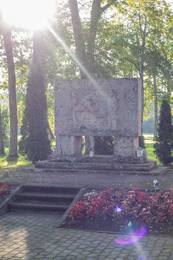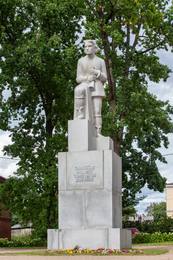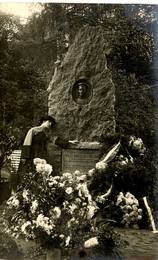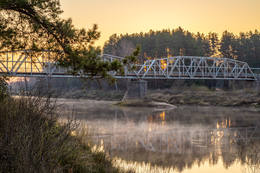LKOK, Colonel Jorģis Zemitāns (1873-1928)
I World War I, I Wars of Independence
Jorģis Zemitāns was born on February 23, 1873 in Skrīveri parish, educated himself. He graduated from the Vilnius Junkers School in 1897. During World War I, he fought in East Prussia, where he was captured by the Germans in 1915.
After returning from captivity, on December 7, 1918, Zemitāns volunteered for the Latvian Armed Forces and became the commander of the 2nd Riga Guard Company and the chief of the Riga Guard and Latvian troops. After the fall of Riga, on January 10, 1919, in Liepāja, he was appointed the authorized military representative of the Latvian Provisional Government in Estonia. With the permission of the Estonian government, Zemitāns began to form six Latvian self-defense companies in Tallinn, Pärnu and Tērbat, which participated in the battles with the Bolshevik units in Estonia, but on February 1, 1919, together with units of the Estonian army, he liberated Rūjiena and the seven parishes in its vicinity. On February 2, the Minister of Defense of Latvia, Jānis Zālītis, appointed Zemitāns the commander-in-chief of the North Latvian Brigade that was being formed. On February 28, he was promoted to general (lieutenant colonel), and on March 13 - to colonel. Zemitāns is credited with the main merits in the formation and unification of the Northern Latvian armed forces, as well as in the battles of the War of Independence in Vidzeme. In June 1919, the Estonian armed forces and the Northern Latvian brigade defeated parts of the German Landeswehr and the Iron Division in the Battle of Cēsis. On July 6, 1919, Zemitāns rode into Riga on a white horse at the head of parts of the Northern Latvian brigade.
On July 15, 1919, Zemitāns was appointed commander of the 2nd Vidzeme Division and commander of the Southern Front. On July 17, he was assigned to oversee the defense of Riga and its surroundings. On October 12, due to the hasty order to retreat from Riga, when the Bermont army began its attack, he was relieved of his post and transferred to the reserve of officers of the staff of the Supreme Commander of the Army. From January 1920, Zemitāns worked in commissions for the development of military draft laws and regulations, and was also a temporary member of the Military Court. In 1921, he was transferred to the reserve of officers of the General Staff. On April 1, 1922, due to staff reductions, he was dismissed from the army.
Colonel Jorģis Zemitāns died on January 16, 1928, and was buried in the Riga Brothers' Cemetery.
For his participation in the battles of World War I, Zemitāns was awarded the Orders of Vladimir, IV class, and Stanislav, III class. In 1924, for the establishment of the Northern Latvian Brigade, the liberation of Northern Latvia, and the defeat of German troops near Cēsis, he was awarded the Lāčplēsis War Order, III class (Order No. 1678). Zemitāns was also awarded the Estonian Cross of Freedom, 1st class, 2nd degree.
In honor of the colonel's memory, in 1928 the railway station in Riga, Aleksandras vārti, was renamed Zemitāni. After World War II, the station was renamed Oškalni in honor of the red partisan Otomārs Oškalns. It regained the name Zemitāni in 1995.
In 1933, Skrīveri Elementary School was given the name of Colonel Jorģis Zemitāns Six-Grade Elementary School, which existed until 1947, when it was renamed after the writer Andrejs Upītis.
On September 27, 1995, a monument to Colonel Jorgis Zemitans was unveiled in the Teika district of Riga, in the square named after him.
More information sources
http://old.historia.lv/alfabets/Z/Ze/zemitans_jorgis/zemitans_jorgis.htm
Cavaliers of the Order of the Lāčplēsis War: Biographical Dictionary. Riga: Jāņa Sēta, 1995. p. 582.
Senior officers of the Latvian army 1918-1940. Biographical dictionary. (comp. Ēriks Jēkabsons, Valters Ščerbinskis); Latvian State Historical Archives., p. 508.
Related objects
Brothers' Cemetery in Riga
Riga Brothers’ Cemetery is located in the northern district of Riga. The cemetery extends over an area of 9 ha and is the most outstanding and significant memorial ensemble in Latvia dedicated to the fallen Latvian soldiers. About 3,000 soldiers are buried here. The Brothers’ Cemetery was created during World War I after the first three Latvian Riflemen, who fell in Tīreļpurvs in the battle against the German Army, were buried here. Later Latvian soldiers who had died in other battles and wars would also be buried in the Brothers’ Cemetery. The memorial is based on the design of the sculptor Kārlis Zāle, and is the first memorial ensemble in Europe with such landscape, architecture and sculptural value. It uses elements typical to the Latvian landscape, traditional farmsteads, Latvian folklore and history that praise the characteristics of soldiers and tell the story of the way of the soldier. The memorial was unveiled in 1936 and it has three parts: ‘The Road of Though’ which is a 250 m long alley, ‘Terrace of Heroes’ with the Altar of the Sacred Flame and ensemble the Sacred Oak Grove, and the burial ground with the Latvian wall and a memorial of a mother with her fallen sons.
Monument to the Liberators of Northern Latvia
Located in the center of Plāčis near the Inčukalns - Valkas highway (A3). Next to the bus stop and Straupes Community Center.
The monument created by Teodors Zaļkalns to the liberators of Northern Latvia in the Battle of Cēsis in 1919 is visible.
On a three-tiered base, two travertine pillars are placed, on which a travertine block rests. On its front, a bas-relief depicts a horse harnessed to a plow and a plowman, who holds the reins in his right hand and a sword in his left. On the back of the monument is carved a text, which concludes with the lines of the poet Eduards Virza:
TO THE LIBERATORS OF NORTHERN LATVIA
WHILE ONE GRAIN IS SOWED IN THIS FIELD
YOU WILL BE PRAISED AND HONORED
The monument was unveiled on November 8, 1931. The opening was attended by President Alberts Kviesis.
Monument “Tālavas taurētājs”
Located in Rūjiena Center Square.
The three-meter-high image of an ancient Latvian guard soldier, carved from gray Finnish granite, called the “Tālavas trumpeter”, is placed on a three-meter-high granite pedestal, but the total height of the monument reaches 7.5 meters. In the initial sketches and models, K. Zemdega had placed a sword in the warrior’s hands, which was later replaced with a trumpet. The monument was unveiled on August 15, 1937.
This monument reflects the difficult situation in the formation of our state and army, as well as the assessment of these events. Immediately after the proclamation of the Latvian state, the Red Army invasion began and the provisional government of Kārlis Ulmanis found refuge in Liepāja. In February 1919, with the help of the Estonian army, the liberation of Latvia from the north began and the first mobilizations of the Latvian troops being formed in Tērbatas took place in the Rūjiena area, which, under the command of Colonel Jorģis Zemitāns, became the North Latvian Brigade. The North Latvian Brigade fought not only against the Bolsheviks, but also against the Landeswehr and the Iron Division in the battles of Cēsis. The North Latvian soldiers mobilized in the Rūjiena area also fought in subsequent battles of the War of Independence. After the war, the main laurels of victory went to General Jānis Balodis and the South Latvian Brigade commanded by him, but the North Latvian Brigade was often forgotten. The planned monument to the North Latvian Brigade in Rūjiena also took a long time to be created, and the monument, unveiled in 1937, was officially promoted as a monument to the liberation of the Rūjiena region and in memory of the fallen soldiers, without mentioning that all the regiments that were part of the North Latvian Brigade had their beginnings in Rūjiena.
The monument is not only a popular tourist attraction for Latvian and Estonian tourists, which is to some extent a starting point for visiting several other War of Independence memorial sites in Rūjiena, but the "Tālavas tauretājs" is also a stopping point for visits by Estonian and Latvian state and local government officials of various levels.
The Rūjiena Liberation and Fallen Soldiers Monument, more commonly known as the "Tālavas tauretājs" (Far-away Horner), was included in the list of state-protected cultural monuments on October 29, 1998 as an art monument of national importance (monument protection registration number 4522).
Monument to Naval Lieutenant, L.k.o.k. Vilis Gelbes (1890-1919)
Located at the Limbaži Jūras Street Cemetery, Jūras Street 56, Limbaži
On display is a monument unveiled on September 10, 1922 by the then President of Latvia, Jānis Čakste, which contains the dedication of the poet Vilis Plūdonis to Vilis Gelb:
"My people, who pass by me, burn with love for your fatherland,
"For the sake of my beloved fatherland, I pledge my life."
Vilis Gelbe (1890-1919) was born in Courland, in Zemīte parish, but was also closely connected to the Limbaži side, because when the Latvian War of Independence began, he returned to Latvia from St. Petersburg and joined the North Latvian Brigade.
In May 1919, V. Gelbi commanded in Limbaži, he became the military commandant of the area and was able to inspire the local men and even very young boys to join the army.
V. Gelbe's activities in Limbaži and its surroundings at that time were very significant; his duties included not only maintaining order in the city and its surroundings, but also mobilization, providing food for soldiers and horses, and resolving many other issues that could not be included in orders and instructions. The commandant's team organized by him acted as a coordinated mechanism to provide the North Latvian Brigade with the most effective assistance possible. The commandant's team went to the aid of the regular army in special cases, and he set an example for the new soldiers. V. Gelbe was the first officer of the Latvian army who proposed awarding his subordinates with the Order of Imanta, Class III. The order did not yet exist. The name of Imanta appeared in public only on March 20, 1920, when a presentation on the establishment of a military order was submitted to the Minister of Security, Kārlis Ulmanis. However, the name of Lāčplēsis was chosen for the order.
During the Battle of Cēsis, Vilis Gelbe died - on June 19, 1919, during a reconnaissance mission. Gelbe was later awarded the Lāčplēsis War Order, but historians believe that his contribution has not been properly appreciated. This is mainly due to Gelbe's membership in the North Latvian Brigade.
The so-called Southern Latvian Brigade, initially commanded by Oskars Kaplaks and later by Jānis Baložs, competed with the Northern Latvian Brigade, commanded by Jorģis Zemitāns.
Iron bridge over the Gauja River in Valmiera
Located in Valmiera, near the Ģīme nature trail on Leona Paegles Street.
The steel-framed iron bridge over the Gauja River was built in 1911. It connected the 114 km long route Ainaži-Valmiera-Smiltene, which was last completed in 1971.
After the liberation of Riga on May 22, 1919, parts of the Soviet Latvian army retreated along the entire front without offering any serious resistance. On May 26, the Estonian National Army and the Northern Latvian Brigade led by Colonel Jorgis Zemitāns occupied Valmiera. “The bigwigs blew up the railway bridge at around six o’clock in the afternoon. At 7:50 they also set fire to both wooden bridges. This did not prevent Estonian troops from entering the city from the Valmiera Manor in the evening of the same day* [..]”
Today, the iron bridge is a favorite place for recreation and walking and a section of the "Green Railway" bicycle route.
* The first to arrive was a cadet company of the 6th Estonian Infantry Regiment, accompanied by several armored vehicles.
Zemitāna laukums
Jorģis Zemitāns (1873–1928) – a graduate of the Vilnius Military Academy, served in the Russian Imperial Army, was taken prisoner by the Germans during World War I. Colonel of the Latvian Army, Knight of the Lāčplēsis War Order, 3rd Class, Knight of the Estonian Order of the Cross of Freedom, Commander of the Northern Latvian Brigade during the Liberation Wars. Skrīveri Primary School, streets in Riga, Skrīveri and Strenči, a square and a railway station in Riga are named after him.
In a square surrounded by lime trees between Brīvības, Lielvārdes and Zemitānas streets, a monument to J. Zemitānas, created by sculptor Gunta Zemīte and stonemasons Ivars Feldbergs and Jānis Metuzāls, was unveiled in 1995. Its location is not frontal, but diagonal to the buildings and the approach road. The arch, carved in granite like a rainbow, placed on the pedestal blocks forms the emblem of the independence struggle recognizable in the riflemen's cockades and breastplates – the motif of the rising sun. On the left side of the main facade, a dedication inscription is carved on the pedestal: "To Colonel of the Latvian Army Jorģis Zemitānas". The 1.84m high monument is surrounded by a carefully tended, magnificently blooming flower bed.
Related stories
Fragment from the founding of the Northern Latvian Army on the Rūjiena side
The North Latvian Army was a Latvian military formation during the Latvian War of Independence, which was formed from 3 February to 31 March 1919 in the territory of Estonia and the Northern Vidzeme regions liberated by the Estonian Army. Until July 1919, the brigade was subordinate to the Estonian Armed Forces Headquarters and the Commander-in-Chief of the Estonian Army in terms of logistics and operations. It was then merged with the South Latvian Brigade, forming the Latvian Army.
About the national patriot First Lieutenant Vili Gelbi
The fate of Lieutenant Colonel Vilis Gelbe (1890-1919) reflects the difficult situation in the formation of our state and army, as well as the assessment of these events.
With the proclamation of the Latvian state on November 18, 1918, the Latvian War of Independence and the work of building the armed forces began. In the first ranks of the Latvian volunteer soldiers was the naval lieutenant Vilis Gelbe, who was born in Courland.
The beginning, course and conclusion of the Battle of Cēsis
The victory in the Battle of Cēsis was destined to become a turning point in the Latvian and Estonian struggle for the independence of their country. This victory put an end to the plans of the Andrievs Niedra government and the German general Rüdiger von der Goltz to conquer the Baltics. Instead, the Latvian Provisional Government of Kārlis Ulmanis resumed its activities in Liepāja.
About the first Commander-in-Chief of the Latvian Army, Dāvids Sīmansons
The essays in the book "Commanders of the Latvian Army" convince us that history is significantly influenced by specific individuals. Although they were at the epicenter of the most important historical events for a short time, true Latvian patriots, with their rich military experience, managed to do a lot in the formation and strengthening of the Latvian army and in the turning points of historical events.
This story is about the first Commander-in-Chief of the Latvian Army, Dāvids Sīmansons (1859-1933).
7. Formation of the Sigulda Infantry Regiment
On June 20, 1919, the 7th Sigulda Infantry Regiment began to be formed in Naukšēni Manor, near Rūjiena, according to the order of the commander of the North Latvian Brigade, Colonel Jorģis Zemitāns. Initially, a small combat group consisting of 22 officers and 1,580 soldiers was formed from the reserve battalion of the North Latvian Brigade, which, in honor of its first commander Oskars Danker, was named the Danker Division. A few days later, the division was included in the 2nd Battalion of the 3rd Jelgava Regiment, and on August 23, with the addition of a company, it was included in the 7th Sigulda Infantry Regiment.




